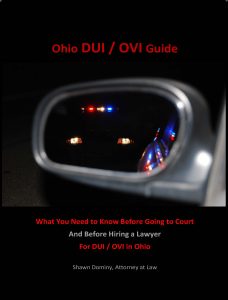 A previous article in this blog discussed the potential impact of hypoglycemia (low blood sugar) on an investigation for DUI (called ‘OVI’ in Ohio). Hypoglycemia is not the only blood sugar condition which may affect an OVI investigation. Hyperglycemia (high blood sugar) may also cause symptoms which overlap with the symptoms of alcohol intoxication. In addition, hyperglycemia may inflate the results of a breath alcohol test.
A previous article in this blog discussed the potential impact of hypoglycemia (low blood sugar) on an investigation for DUI (called ‘OVI’ in Ohio). Hypoglycemia is not the only blood sugar condition which may affect an OVI investigation. Hyperglycemia (high blood sugar) may also cause symptoms which overlap with the symptoms of alcohol intoxication. In addition, hyperglycemia may inflate the results of a breath alcohol test.
Articles Posted in DUI/OVI field sobriety tests
ADHD and DUI/OVI in OH
 Driving is an activity which requires sustained attention. Drivers must focus on driving and divide their attention among multiple parts of the driving activity: steering, acceleration, braking, watching the speedometer, watching the road, and reacting to a constantly changing environment. For DUI investigations (called ‘OVI’ in Ohio), law enforcement officers are taught to look for problems with attention and administer divided attention sobriety tests. What happens when the subject of an OVI investigation is a driver with ADHD?
Driving is an activity which requires sustained attention. Drivers must focus on driving and divide their attention among multiple parts of the driving activity: steering, acceleration, braking, watching the speedometer, watching the road, and reacting to a constantly changing environment. For DUI investigations (called ‘OVI’ in Ohio), law enforcement officers are taught to look for problems with attention and administer divided attention sobriety tests. What happens when the subject of an OVI investigation is a driver with ADHD?
Hypoglycemia and DUI / OVI in Ohio
 There are situations in which a law enforcement officer observes signs which appear to be symptoms of alcohol intoxication but are actually symptoms of a medical condition. One of those situations is when a driver is experiencing hypoglycemia (low blood sugar). The symptoms of hypoglycemia are nearly identical to the symptoms of alcohol intoxication. A driver experiencing a hypoglycemic event at the time of an OVI investigation has a legitimate defense to the charge of DUI (called ‘OVI’ in Ohio).
There are situations in which a law enforcement officer observes signs which appear to be symptoms of alcohol intoxication but are actually symptoms of a medical condition. One of those situations is when a driver is experiencing hypoglycemia (low blood sugar). The symptoms of hypoglycemia are nearly identical to the symptoms of alcohol intoxication. A driver experiencing a hypoglycemic event at the time of an OVI investigation has a legitimate defense to the charge of DUI (called ‘OVI’ in Ohio).
Driving School Tests Skills of Drunk Drivers
 The Chikushino Police Department has a program in which driving instructors test the driving skills of volunteers who are under the influence of alcohol. According to a CNN article, testing impaired drivers is part of a drunk driving awareness campaign. In Ohio, we do not use drunk driving exams to determine if drivers are impaired by alcohol or drugs. Instead, we use field sobriety tests and blood/breath/urine tests. Those tests are circumstantial evidence that a person was operating a vehicle under the influence.
The Chikushino Police Department has a program in which driving instructors test the driving skills of volunteers who are under the influence of alcohol. According to a CNN article, testing impaired drivers is part of a drunk driving awareness campaign. In Ohio, we do not use drunk driving exams to determine if drivers are impaired by alcohol or drugs. Instead, we use field sobriety tests and blood/breath/urine tests. Those tests are circumstantial evidence that a person was operating a vehicle under the influence.
New Study Addresses Usefulness of Field Sobriety Tests Used in Ohio
 An article published earlier this month addresses the accuracy of field sobriety tests (FSTs). A team of researchers set-out to evaluate the effectiveness of FSTs for identifying drivers under the influence of THC. The researchers conducted clinical trials involving THC use, field sobriety testing, and driving simulations. The clinical trials showed the FSTs do not effectively discriminate between people who are impaired and people who are not impaired.
An article published earlier this month addresses the accuracy of field sobriety tests (FSTs). A team of researchers set-out to evaluate the effectiveness of FSTs for identifying drivers under the influence of THC. The researchers conducted clinical trials involving THC use, field sobriety testing, and driving simulations. The clinical trials showed the FSTs do not effectively discriminate between people who are impaired and people who are not impaired.
Motions To Suppress Evidence in Ohio DUI / OVI Cases
 I recently came across this article in an Ohio newspaper: Judge Denies Motion to Suppress Evidence. What does that mean in a DUI case (called ‘OVI’ in Ohio)? When a judge orders that evidence is suppressed, the evidence is excluded from trial. That means, even though the evidence existed, the jury does not hear about it. The two general bases for suppressing evidence are: (1) violations of the defendant’s Constitutional rights; and (2) the government’s failure to comply with statutory (legislative) law.
I recently came across this article in an Ohio newspaper: Judge Denies Motion to Suppress Evidence. What does that mean in a DUI case (called ‘OVI’ in Ohio)? When a judge orders that evidence is suppressed, the evidence is excluded from trial. That means, even though the evidence existed, the jury does not hear about it. The two general bases for suppressing evidence are: (1) violations of the defendant’s Constitutional rights; and (2) the government’s failure to comply with statutory (legislative) law.
Blood Test Clears Sober Parent of DUI and Child Endangering
 Imagine you are totally sober, but your child’s daycare calls the police and reports you may be intoxicated. Imagine further the police make you perform field sobriety tests while your toddler is running around on the sidewalk. Now imagine you are prosecuted for DUI (called ‘OVI’ in Ohio) and Child Endangering and your child is taken away from you for two months, only for a blood test to show no alcohol or drugs, because you were totally sober. Katie Slayton does not have to imagine it: it happened to her. Her experience was the perfect storm of circumstances in a DUI/OVI investigation.
Imagine you are totally sober, but your child’s daycare calls the police and reports you may be intoxicated. Imagine further the police make you perform field sobriety tests while your toddler is running around on the sidewalk. Now imagine you are prosecuted for DUI (called ‘OVI’ in Ohio) and Child Endangering and your child is taken away from you for two months, only for a blood test to show no alcohol or drugs, because you were totally sober. Katie Slayton does not have to imagine it: it happened to her. Her experience was the perfect storm of circumstances in a DUI/OVI investigation.
Britt Reid’s Case And Vehicular Assault Investigations
 A few days before the Kansas City Chiefs were to play in the Super Bowl, assistant coach Britt Reid (son of head coach Andy Reid) was involved in a three-car accident which left a five-year-old in critical condition. Earlier this month, Britt Reid was charged with the felony offense of ‘DWI-Serious Physical Injury’. While this incident occurred in Missouri, the investigation which led to the charge is essentially the same as a Vehicular Assault investigation in Ohio.
A few days before the Kansas City Chiefs were to play in the Super Bowl, assistant coach Britt Reid (son of head coach Andy Reid) was involved in a three-car accident which left a five-year-old in critical condition. Earlier this month, Britt Reid was charged with the felony offense of ‘DWI-Serious Physical Injury’. While this incident occurred in Missouri, the investigation which led to the charge is essentially the same as a Vehicular Assault investigation in Ohio.
New Book For Those Charged With DUI / OVI: The “Ohio DUI/OVI Guide”
 Many people charged with DUI (called ‘OVI’ in Ohio), especially those charged with a first offense, feel like they are in the dark. They do not understand the elements and consequences of OVI, and they do not know what to expect in the court process. They also are uncertain about whether to hire a lawyer and how to find a good defense attorney. I recently published a new book, the Ohio DUI/OVI Guide, which answers most of the questions people ask in this situation. My hope is that those who read the guide will no longer be in the dark.
Many people charged with DUI (called ‘OVI’ in Ohio), especially those charged with a first offense, feel like they are in the dark. They do not understand the elements and consequences of OVI, and they do not know what to expect in the court process. They also are uncertain about whether to hire a lawyer and how to find a good defense attorney. I recently published a new book, the Ohio DUI/OVI Guide, which answers most of the questions people ask in this situation. My hope is that those who read the guide will no longer be in the dark.
Court Disbelieves Officer And Concludes Arrest Was Unlawful In Ohio DUI/OVI Case
 The credibility of a law enforcement officer makes a difference in court. Judges seem to presume officers are credible. Officers, however, can ruin their credibility with unprofessional conduct, uncorroborated claims, and unconfirmed clues. The trooper in a recent Franklin County case did just that, and it resulted in the court of appeals concluding the trooper’s arrest of the defendant was unlawful.
The credibility of a law enforcement officer makes a difference in court. Judges seem to presume officers are credible. Officers, however, can ruin their credibility with unprofessional conduct, uncorroborated claims, and unconfirmed clues. The trooper in a recent Franklin County case did just that, and it resulted in the court of appeals concluding the trooper’s arrest of the defendant was unlawful.
 Columbus OVI/DUI Attorney Blog
Columbus OVI/DUI Attorney Blog

